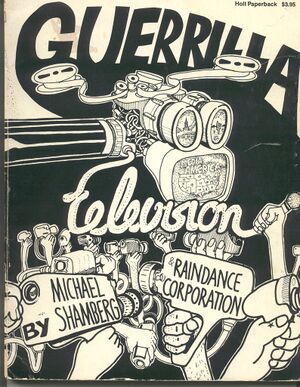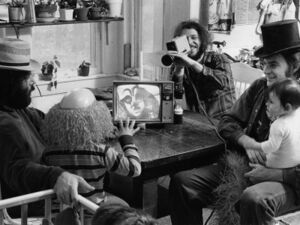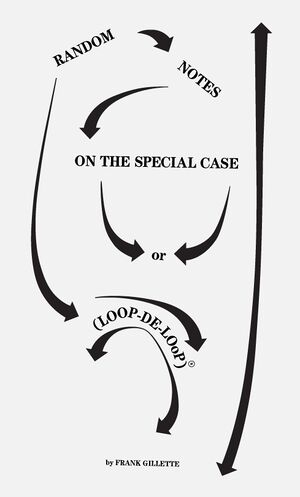Double Bind's Double life
GREGORY BATESON - TOWARD A (MEDIA) ECOLOGY
Gregory Bateson's ideas, which crossed between ecology and media ecology, were seminal in the development of video art in the late 1960s and early 1970s. Bateson had been a prominent and active voice in debates about art and society throughout the 1950s[1] which shifted emphasis away from the artistic product (the painting or sculpture) and toward the context in which such an object is created. Central to Bateson's cybernetic aesthetics was self-reflexivity (by the artist and the audience of art) as a condition of artistic production. In 1957 Bateson and Marcel Duchamp joined Frank Lloyd Wright and Mayer Shapiro at the American Federation of Arts Conference. It was here that Bateson outlined a (media) ecological understanding of art. Schipiro represented the old-guard, regarding painting's foremost virtue to be its fundamental opposition to mass media, a view which was opposed by Bateson and Duchamp.[2] Duchamp delivered his now famous paper The Creative Act with Bateson presenting a text entitled Creative Imagination which was later published in STEM.[3]
The 1957 conference was noteworthy because it attracted a much larger audience than expected and because there was an insistence from those presenting, and the audience to discuss communication systems in relation to the arts. This was in the wake of an increased mass media presence and as the discourse on cybernetics became accessible to more people through (for instance) Norbert Wiener's books, a popularisation of Claude Shannon’s Information Theory as well as Bateson's own writing, including Communication and the Social Matrix of Psychiatry (with Jurgen Ruesch). Duchamp's paper sidesteps Schipiro's conservative position and holds the communicative and medial nature of art to be beyond the intention of the artist. The public decodes or "deciphers" the intentions of the artist and in so doing become creators of it.[4]
Bateson's paper is more assuredly cybernetic in nature. The Creative Imagination addresses the particular nature of artistic communication, which, as opposed to everyday communication, is a means of meta-level communication, art for Bateson is inherently self-reflexive, it communicates about communication. If Schipiro was interested in art as a form of resistance, or bulwark, to communication, a space immune from the perennial effects of communication, Bateson sees art as a play between different levels of communication, a play which makes those different levels visible.[5].
This position would be the central tenet of early video art and the media theory discussed in Radical Software and would be a formative influence on artists such as Dan Graham (profoundly influenced by Bateson and Radical Software). For Bateson, aesthetic awareness allows for an understanding of the process by which it is possible to acquire knowledge. This produces the grounds on which a communications system is framed to be made visible, which for a generation of artists in the 1960s and 70s situated art as an inherently self-reflexive, self-critical and context-critical endeavour. For Bateson communication produces context and further reflection on the production of that context.[6]
This medial reading of aesthetics is in line with the valorization of creativity which was part of the post WWII's reinvention of the liberal subject: the self-reflexive self, constituted within media circuits (media-ecologies), which Bateson and Ruesch's Communication and the Social Matrix of Psychiatry had concerned itself. Here the self is beyond the individual subjectivity of ‘I’, mind is "immanent in the larger system, man plus environment. Communication is the "substance of common being".[7] Central to Bateson’s understanding of art was a conception of aesthetics as a form of ‘deutero-learning’ which deals with “context and classes of context” (as opposed to proto-learning which deals with “narrow fact”).[8]
When artistic practice and discourse finally adopted ideas of self-reflexivity and radical mediality in the late 1960s and early 1970s it was largely because of the influence Bateson had exacted on the counterculture from the 1960s on. Bateson’s vision of 'mind' as unbounded within a field of technological communication found resonance with a generation raised on the mass media and had also felt the alienating affects of that media. Many had also experienced some dissolution of the essential self through exposure to hallucinogenics, which provided a model demonstration of a self which is medial and co-exensive Gregory Bateson himself had been a participant in the CIA’s LSD experiments in the 1950s. [9] In 1959 Bateson helped arrange for his friend, the beat poet Allen Ginsberg, to take the drug at a research program located off the Stanford campus (see chapter E-Meter).[10] This was the same programme at which Ken Keasy and Stuart Brand met. Keasy and Brand went on to organise the multi-media Trips Festival in 1966. [11] In the following year Kesey and his Merry Pranksters boarded the magic bus and in 1968 Brand (a semi-detached merry prankster) founded the Whole Earth Catalog.[12]
The attitudes and practices of the 1960s counterculture were extended and re-coded into self-sufficient media ecologies as the 1970s approached, flowing through the output of media groups such as Raindance, TVTV (Top Value TeleVision), Ant Farm, The Woodstock Community Video and Videofreex.[13] In the era of second-order cybernetics the emphasis was on experiments in technologies of self – re-programming the system, programming the community. In the 1970s the "access to tools" was still an essential concern, along with an insistence that media should be aid cultural cohesion.
Within this context the conflated term ‘media ecology’ was developed in the pages of Radical Software in the early 1970s. Arlo Raymond attempted a definition in issue 1. Media ecology was, for him: :”the study of media and communications and its affect on media and society.”[14] In STEM, Bateson took a more radical position, within a media ecology there is no distinction among technology, affect, and sociability.[15]


RADICAL SOFTWARE - TOWARD A (MEDIA) ECOLOGY
The Raindance Corporation was established as a platform for media activism, users of new video technology and as a "think tank" – a radical alternative to the RAND Corporation.[16] Radical Software, which became the editorial outlet for Raindance, was founded by Beryl Korot and Phyllis Gershuny.[17]
It provided a forum for discussion, the decimation of information and the formulation of media theory as well as a platform for established writers and theorists. The founders and contributors to Radical Software were largely artists working with the new Portapak video system which became accessible at the end of the 1960s. At the cost of $1495 it was not cheap, but it was in the range of many more users than had previously been the case, and could be easily acquired by collectives. Tapes were easy to distribute, and could be re-used and copied. The second technological revolution came in the form of cable (CATV). Ralph Lee Smith’s article The Wired Nation (1970) heralded a new media revolution which would accord access to the contact of “newspapers, mail service, banking and shopping facilities, data from libraries and other storage centres, school curricula and other forms of information too numerous to specify. In short, every home and office will contain a communications centre of a breadth and flexibility to influence every aspect of private and community life.”[18] The artists Frank Gillette and Ira Schnider, in the first issue of Radical Software (1970), recognised that the combination of cable hooked up to portable video equipment would break the ecology of the mass media, radically changing the subject positions of producers and consumers of media.[19] CATV, like CCTV, was a closed circuit system extended to a very great extent allowing for a feedback loop of communication between participants over a great distances.[20] The recursive structure of this system could take the form of shared communication and could equally create positive feedback (noise). Both feedback as noise and negative feedback as a system of control offered political and artistic potential which the community around Radical Software were keen to exploit.

Raindance and Michael Shemberg’s publication Guerrilla Television (with graphics by architect-design collective Antfarm) (1971) would identify mainstream ‘Media America’ as designed to minimise such feedback, allowing only a one-way flow between sender and receiver. This resulted in an accumulation of cultural power into the hands of corporate America. Portable video systems, along with access to cable technology, would help redress this imbalance. A principle platform in the pages of Radical Software, therefore, was to lobby for the open uses of CATV (the appointment of licences began in 1970). Between 1968 and 1972 cable operators offered support to community based projects, this was exploited by a wave of artist-activist initiatives and underwritten by New York State Council for the Arts (which in 1970 increased its budget to the arts from $2m to $20m). Initiatives by artists and artist collectives also received support from private foundations. The emphasis and motivation on the community of video artists working for and around Radical Software was on community based media projects and ecological activist projects (the annual Earth Day began in 1970). [21] Paul Ryan had worked for Marshall McLuhan whilst McLuhan was visiting professor at Fordam University (1967-1968). McLuhan gave Ryan access to Sony Portapaks and tape that McLuhan had received from from Sony (he had little practical use for them). [22]

Ryan and Gillette, along with their colleague Roy Skodnick would become key architects in the discourse of video-art-activism as it emerged from the ecological movement. They produced seminal works, texts and forums for theory and practice (often through the offices of Raindance and Radical Software). Radical software combined pragmatic advice of how to work the technology with an emergent theoretical framework which considered the implications of that technology on future culture and society.[23] Ryan was inspired by McLuhan at his most optimistic, who in Understanding Media, had posited that electronic media could result in “the ultimate harmony of all being” [24], this, in Radical Software was tempered with a politically critical approach which advocated “Cybernetic Guerrilla Warfare”[25] which challenged the "top down" monopolies of Media America.



If the Portapak as a piece of technology encouraged a radical new form of social-media and media collectivity, it also allowed for the creation of artworks which made the individuals place within a media circuitry visible. Paul Ryan’s Everyman’s Mobius Strip (1969), Frank Gillette and Ira Scheider’s Wipe Cycle (1968),and Dan Graham’s TV Camera/ Monitor Performance (1971); Frank Gillette’s, Video: Process and Meta-Process (1973) all performed the logic of the self as co-extensive to a given system =(nervous system, system, environment). As Skodnick was to reflect years later, social movements and media movements were converging “[…] with Bateson as principle guide to the complexities of nature and culture. [Frank] Gillette did it, Randy Sherman did it, and apparently [Dan] Graham did it too. Anyone who happened to get hold of a portable video system at the time immediately overloaded on circuits, playback, feedback and fabulous loop de loop.” [26]The Porta Pak, Skodnick observed, was a “beautiful system” that not only allowed the user to “ track social behaviour but also to see how social behaviour is framed […] TV dissolved into a more plastic language.” Skodnick continues, “ [T]here was a full-bore media war of information then, and visual information was fully up for grabs. We could put ourselves in it, see ourselves seeing ourselves, and even enter the jouster with the ‘News cycle’ emptying out, as was demonstrated in [Gillette’s] Wipe Cycle.” Such was the “radical ecology of Radical Software”. [27] Paul Ryan: “Video itself mutated from a counter cultural gesture to an art genre. When video was principally a countercultural gesture, it held the promise of social change unmediated by the art world. Now, whatever promise of social change video holds is mediated by the art world. This is a significant difference. People unfamiliar with the mutation find it difficult to appreciate the unlimited sense of possibility that early video held.”
It was in this milieu that Bateson's ideas made their transition from the sphere of ecology into media art. For Bateson, in the realms of anthropology, psychiatry, ecology and aesthetics the self-reflexive subject is central, the medial subject who recognises their place within a hierarchy of abstraction The progression from Behaviour, Teleology & Purpose, the McCulloch-Pitts model, Norbert Wiener’s negentropy and, Ashby’s Homeostat to the emerging ecology movement and its abiding connection to media ecology can be found in Bateson's 1968 essays Effects of Conscious Purpose and Human Adaptation [28] and The Roots of Ecological Crisis[29].[discussed in the previous chapter] In these Bateson returns to the beginning of the fabulous loop de loop, and to the evolutionary models that had excited Samual Butler's imagination a century before, to the 'vapour engine' which, even on this side of the fabulous loop de loop, serves again as a model for evolution.
- ↑ For instance, Bateson was a member of the Western Roundtable on Modern Art in San Francisco in 1949, which included Marcel Duchamp.
- ↑ William Kaizen, Steps to an Ecology of Communication: Radical Software, Dan Graham, and the Legacy of Gregory Bateson: Art Journal, Vol. 67, No. 3 (FALL 2008), pp. 86-107, p92
- ↑ M.Duchamp The Creative Act, ART-news Vol. 56, no. 4, 1957
- ↑ M.Duchamp The Creative Act, ART-news Vol. 56, no. 4, 1957
- ↑ Gregory Bateson The Creative Imagination Stem p
- ↑ William Kaizen, Steps to an Ecology of Communication: Radical Software, Dan Graham, and the Legacy of Gregory Bateson: Art Journal, Vol. 67, No. 3 (FALL 2008), pp. 86-107 pp. 93-94
- ↑ Bateson, in William Kaizen, Steps to an Ecology of Communication: Radical Software, Dan Graham, and the Legacy of Gregory Bateson: Art Journal, Vol. 67, No. 3 (FALL 2008), pp. 86-107, p94
- ↑ Bateson, Mind and Nature, 156
- ↑ The drug was administered to him by CIA agent Harold Abramson.
- ↑ Marks 1979:120
- ↑ Turner; From Counterculture to Cyberculture, University of Chicago Press, 2008
- ↑ Bateson, through his friendship with Alan Watts, also took an interest in Zen Buddhism as the model for a non-occidental, radically discentered, non-Cartesian philosophy STEVE P. HEIMS: Journal of the History of the Behavioral Sciences 13 ; GREGORY BATESON AND THE MATHEMATICIANS: FROM INTERDISCIPLINARY INTERACTION TO SOCIETAL FUNCTIONS 1977, 141-159
- ↑ David Joselit Feedback: Television Against Democracy, MIT Press 2007
- ↑ Arlo Raymond, Media Ecology Radical Software Issue 1
- ↑ Bateson STEM. 87
- ↑ The Research ANd Development arm of the industrial, military, academic complex)
- ↑ All past issues are archived here https://www.radicalsoftware.org/e/index.html
- ↑ Lee Smith, in Joselit's Feedback, Television Against Democracy, MIT, 2007 p91
- ↑ Radical Software, Issue 1. 1970
- ↑ David Joselit's Feedback, Television Against Democracy, MIT, 2007 pp 96-97
- ↑ David Joselit Feedback, Television Against Democracy, MIT, 2007 p98
- ↑ P. Ryan; A Genealogy of Video; Leonardo, Vol. 21, No. 1, 1988, pp. 39-44
- ↑ Paul Ryan, Radical Software issue 4, 1971.
- ↑ McLuhanUnderstanding Media
- ↑ Paul Ryan, Radical Software Issue 4
- ↑ Skodnick: Radical Software and the Legacy of Gregory Bateson Author(s): Paul Ryan and Roy Skodnick; Art Journal, Vol. 68, No. 1 (SPRING 2009), 113
- ↑ Skodnick Radical Software and the Legacy of Gregory Bateson Author(s): Paul Ryan and Roy Skodnick: Art Journal, Vol. 68, No. 1 (SPRING 2009),113
- ↑ Bateson,StEM 446
- ↑ Bateson StEM 494